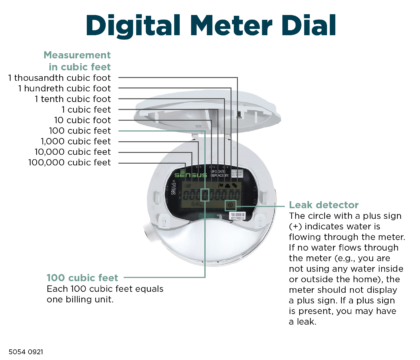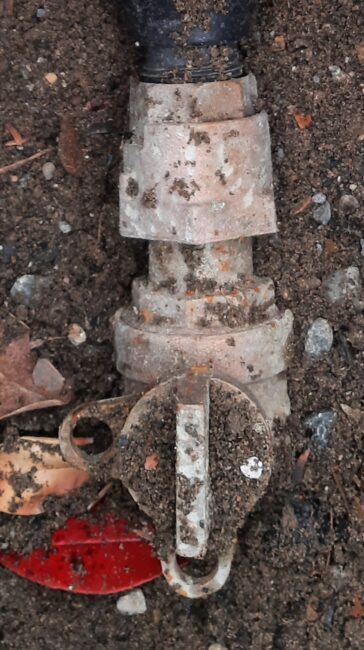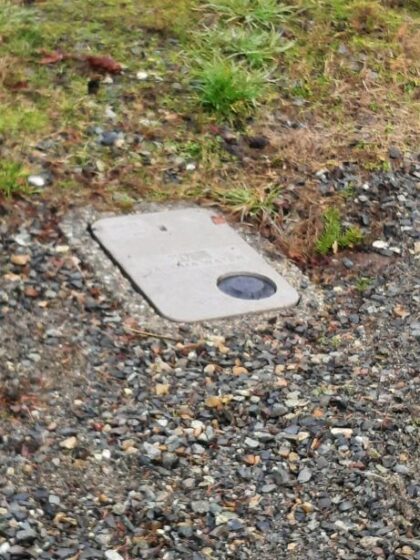Find & Fix Leaks
Nearly one trillion gallons of water are wasted in U.S. homes each year from easy-to-fix leaks. To make matters worse, leaks waste an average of 10,000 gallons of water per home each year. That’s enough water to fill up a backyard swimming pool!
Figure out how much water is leaking in your home using the AWWA’s Drip Calculator.
Finding and fixing household leaks can save homeowners more than 10% on their water bill. Common leaks around the home include leaking or running toilets, dripping faucets and leaking valves. An unexplainable increase in your water bill, particularly after freezing weather, may be a sign you have a leak.
Water Smart Tips:
Finding Leaks
If you suspect a leak, your water meter and usage data can help confirm your suspicion. Make sure all faucets and water-using appliances like dishwashers and sprinklers are turned off and do not use any water during the test.
How to Test for Leaks
- Legacy Meter
-
Your meter is outside, but the location varies from house to house. Usually, it is in line with an outside hose bib. Once you locate your meter, follow these steps:
- Check the number on your water meter, write it down and wait one hour.
- After an hour, if your meter number has changed, and the water has been off, then you may have a leak.
- If your water meter has a low-flow indicator (a small, triangular gauge or wheel), see if it moves while your water is off. It is does, you may have a leak.
- Take corrective measures if you suspect a leak.
- Advanced Meter
-
You can access detailed usage data and check for leaks by logging into MyAccount, our online customer portal. Advanced meters detect leaks based on continuous hourly water consumption. If our records indicate a significant increase in water use, we will verify the information and notify you by letter to take further action. Check your usage by following these steps:
- Click on the “View data” link below the “Usage Graph” label on your MyAccount dashboard.
- A new window opens with the heading “Usage Dashboard.” Click the circle next to “Water” to display water usage data. A graph of monthly water usage appears.
- Next to the heading “Period,” click the dropdown menu to navigate to weekly or daily usage graphs.
- If you have a leak, the standard water use shows a new (non-zero) baseline when the leak possibly started. Most households have zero water use for part of the day. You may have a leak if the graph does not show zero usage.
- Take corrective measures if you suspect a leak.
If you need to read the meter, read it from left to right. The first four numbers represent the total water volume of usage through the meter. The usage is displayed cumulatively since meter installation and is measured in CCF (centum cubic feet or 100 cubic feet).
 To determine how much water you’ve used, subtract your previous meter reading from the present one. Water usage is billed per CCF used. 1 CCF equals 100 cubit feet or 748 gallons.
To determine how much water you’ve used, subtract your previous meter reading from the present one. Water usage is billed per CCF used. 1 CCF equals 100 cubit feet or 748 gallons.The position value of each number on the meter, from left to right, are as follows:
- 100,000 cubic feet
- 10,000 cubic feet
- 1,000 cubic feet
- 100 cubic feet
- 10 cubic feet
- 1 cubic foot
- 1 tenth cubic foot
- 1 hundredth cubic foot
- 1 thousandth cubic foot
If a plus sign (+) is shown inside the circle on the meter display, water is currently flowing through the meter.
How do I access or turn off my water meter?

Yoke Stop
You should turn on/off the service using the existing whole-house shutoff valve located on your property (often in crawlspace, valve box, near water heater). In case of emergency, you may turn on/off the service using the existing equipment (yoke stop valve) within the city meter box (see photo).
Use a long screwdriver or similar tool to remove the lid using the lifting slot in the lid. When remove the meter box lid, be careful not to disconnect or damage the Advanced Meter communications wire. When replacing the lid ensure the cable to not caught between the box and the lid. Once replaced, the lid should fit level with the surrounding grade without rocking.
If you damage the utility equipment you may be charged a fee for the damage.

Water Meter Box Lid
Locating a Leak
Finding the location of your leak involves some detective work. Water leaks that occur in underground pipes can be hard to detect.
There may be financial assistance available to replace your leaking water service line through the Water Grant and Loan Program. Click here to learn more about this program.
Outdoors
- Look for leaks where your hose connects to the hose bib or along your garden hose.
- If you have an automatic sprinkler system or drip irrigation system, look for soggy soil around sprinkler heads after running your sprinkler systems. Also, look for water drops around your automatic control valves.
- Turn on your automatic irrigation system to check for broken sprinkler heads and pipes.
Indoors
- Watch for faucets that drip.
- Look for faucet gaskets or pipe fittings with water on the outside of the pipe.
- Listen for toilets that run after you’ve flushed them, when no one has recently flushed them, or in the middle of the night.
Did You Know?
A dripping faucet that fills an eight-ounce cup in 10 minutes can waste over 3,200 gallons of water per year. Most faucet leaks are caused by old or worn faucet washers, O rings and gaskets.
Many showerheads that leak where the showerhead connects to the pipe can be fixed by using Teflon or pipe tape on the connection between the showerhead and pipe and making sure the connection is tight.
Water Smart Tip: Diagram your fixture when taking it apart to show the order of its pieces. Take broken parts to the hardware store where employees can help you find the right products and provide guidance.
Toilet Leaks
A silent toilet leak, often caused by a flapper that does not completely close, can waste 50 to 500 gallons of water per day. A silent toilet leak that wastes 250 gallons of water per day would cost a City of Tacoma resident more than $50 per month in water and sewer charges.
Check your toilet for leaks:
- Take the lid off the tank, flush and watch for water to come up to the mark impressed into the ceramic of the tank.
- If water comes up higher than the mark level impressed into the ceramic of the tank, it’s easy for water to continuously overflow and run down the drain. If necessary, bend the float arm down so that the re-fill valve shuts off at the mark impressed into the tank. If the re-fill valve leaks, you may want to work with a plumber.
- Put a little food coloring into the tank. This will help determine if a leak exists in or around the flapper at the bottom of the tank.
- Don’t flush. Wait 15 minutes to see if any color appears in the bowl.
If color appears, you probably have a leak at the flapper valve on the bottom of the tank. Flapper leaks can be caused by a worn flapper (easily replaced) or by a corroded flapper valve seat, which needs to be replaced by a plumber. If you replace the flapper, make sure you buy the right one for your toilet. The wrong flapper model may also leak. - Flush your toilet to get rid of the food coloring.
Tacoma Water customers can use our easy online form to request free efficient showerheads, faucet aerators, hose spray nozzles, and more.

